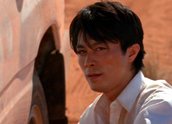


Japanese Story (2003)
Synopsis
Sandy Edwards (Toni Collette), an ambitious young Perth geologist, flies north to Port Hedland to babysit the son of a Japanese industrialist, on a private visit. Hiromitsu Tachibana (Gotaro Tsunashima) marvels at the size of the iron ore mines, but his real purpose is more mysterious. He wants to lose himself in the vastness of the desert, a place he fears. Edwards finds him irritating, demanding and sexist. He finds her loud, aggressive and unfeminine. Their hostility gradually dissipates as they go further into the desert. They become lovers, in awe of the beauty of their natural surroundings. Just as she realises how lonely she was, he is taken away. She must deal with the aftermath in secret grief.
Curator’s notes
The initial impetus for Japanese Story was a single visual idea – a Japanese man driving alone through the Australian desert. Producer Sharon Connolly asked screenwriter Alison Tilson to develop a script, based on this beginning. Five years later, and with a new producer (Sue Maslin) taking over the project, the idea was still intact in the finished film, although the concept had come a long way by then.
In part, it’s a film about the way that Toni Collette’s character is never able to simply belong in her surroundings. She begins the film as a restless, unhappy young woman, with no real home, an uneasy relationship with her mother (Lynette Curran) and a frustration about her career. Her business partner, Bill Baird (Matthew Dyktynksi) is supposed to babysit the Japanese visitor, but dumps the task on her because of his son’s impending fifth birthday party. He assumes it will be fine because she has no life anyway. By the end of the film, Sandy Edwards is once again alone in the world, but with a grief that she never knew was possible. Everything has changed and nothing. She still has no standing, either with Baird, or in the official grieving that’s possible for Hiromitsu’s wife Yukiko (Yumiko Tanaka). What she does have is the memory of a moment of grace and passion in the desert – a temporary period of resolve.
This question of resolution is what drives the film forward, in a startling and original way. It’s not exactly a new question in Australian film – it’s possibly the single most important question in all Australian films dealing with white Australians in the landscape – but Japanese Story is able to dramatise it in a fresh way. Hiromitsu comes to Australia looking for answers to questions he can hardly formulate. Is he running away from his responsibilities as the son of an industrialist? Does he want to die in the desert, or conquer the fear that such vastness instils in him? The film finds interesting ways to dramatise its distinctly difficult questions, and then it throws a plot development so unexpected that it left audiences stunned and disbelieving, and occasionally hostile.
The key to the film’s success is partly that it was prepared to take events in a new direction, with confidence that audiences would follow. Toni Collette’s performance and Ian Baker’s cinematography were two of the reasons that many were prepared to do so. The film was shot largely in the Pilbara region of Western Australia, and Baker’s camera captures the red ferrous beauty of the landscape and its intimidating indifference. ‘People die out here,’ says Sandy, who’s probably more scared of the place than Hiromitsu. She knows what it’s capable of, or thinks she does.
- Overview
- Curator’s notes
- Video 3 clips
- Principal credits
- Find a copy
- Make a comment
- Map
- Add your review



